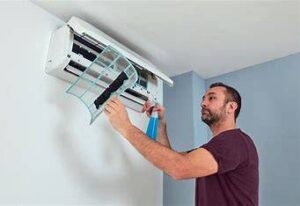Indoor Air Quality (IAQ) test kits might not grab the headlines like smart home gadgets or high-tech air purifiers, yet they play a crucial role in maintaining a healthy living environment. These kits bring a level of precision and specificity to the table that general air quality monitors can’t match, making them an indispensable tool for homeowners and office managers alike. This specialized nature of IAQ test kits allows them to offer insights into the air we breathe in a way that’s both detailed and actionable.
With categories including DIY kits for quick checks and professional-grade options for a comprehensive analysis, there’s an IAQ test kit suited to every need and concern. Single-use radon detectors and long-term mold monitors highlight the variety available, each designed to target specific pollutants. Delving deeper, each type of IAQ test kit not only identifies the presence of pollutants but also quantifies them, offering a clear picture of indoor air quality.
This includes everything from volatile organic compounds (VOCs) and particulate matter to carbon monoxide levels and radon concentration. The subsequent sections will dive into the nuances of these tests, including the technology behind them, their historical development, and tips for interpreting results effectively. This exploration will enrich our understanding of IAQ test kits, underscoring their importance in safeguarding health and well-being in indoor spaces.
Through a detailed examination of their functions, we’ll see how these kits do more than just measure air quality—they provide a roadmap for creating healthier, more comfortable environments.
What is an IAQ test kit?
An IAQ test kit is a specialized tool used to assess the air quality inside homes, offices, and other indoor spaces. These kits are designed to detect and quantify various pollutants, including volatile organic compounds (VOCs), mold, carbon monoxide, and radon gas. They come in different forms, from DIY kits for basic assessments to professional-grade kits for in-depth analysis.
Brands like AirThings, My Mold Detective, and Home Air Check offer popular models that cater to a wide range of needs. For instance, the AirThings Wave Plus provides radon detection alongside VOC and CO2 monitoring, making it a versatile choice for homeowners. Meanwhile, My Mold Detective focuses on mold spore detection, offering a clear picture of mold issues within a property.
Home Air Check offers comprehensive VOC testing, ideal for those concerned about chemical pollutants. Each kit’s process involves collecting air samples from different locations within a building. These samples can then be analyzed in a laboratory for precise identification of pollutants, or some kits provide immediate results through digital monitors.
The primary goal is to uncover hidden air quality issues that could pose health risks. By identifying these pollutants, an IAQ test kit can serve as a critical first step in improving the indoor environment, ensuring it’s safe and healthy for occupants.
Why is testing indoor air quality important?

Testing indoor air quality is pivotal because it uncovers hidden pollutants that could be detrimental to our health. Substances like volatile organic compounds (VOCs), mold, and radon gas often go unnoticed because they can’t always be seen or smelled. By identifying these invisible threats, we can assess and mitigate health risks, safeguarding the well-being of those who inhabit these spaces.
According to the Environmental Protection Agency (EPA), indoor air can be up to five times more polluted than outdoor air, emphasizing the critical need for IAQ testing. Moreover, pinpointing the presence of such pollutants empowers us to improve the indoor environment. For instance, discovering elevated levels of VOCs can lead to enhanced ventilation strategies or the elimination of their sources.
Identifying mold spores prompts remediation efforts, clearing the air and making our indoor environments healthier and more comfortable. The World Health Organization (WHO) reports that poor indoor air quality is linked to a wide range of health issues, from respiratory conditions to long-term chronic diseases, further underscoring the importance of IAQ testing. In short, testing indoor air quality is a proactive step toward preventing potential health problems and ensuring that our indoor spaces are safe, clean, and conducive to our overall health.
What do IAQ test kits measure?
IAQ test kits are essential tools for assessing the quality of air in indoor spaces. They are specifically designed to detect a variety of pollutants that could be detrimental to health and well-being. Key among these are volatile organic compounds (VOCs), which originate from everyday household products and can significantly impact health.
Additionally, these kits measure the presence and concentration of mold spores, alerting to potential mold growth that could cause health issues. Moreover, IAQ tests are capable of detecting carbon monoxide, a harmful gas produced by incomplete combustion, posing serious health risks. They also measure radon gas, a naturally occurring radioactive substance that can seep into buildings from the ground.
Volatile Organic Compounds (VOCs) and their sources
Volatile Organic Compounds (VOCs) are chemicals that easily evaporate at room temperature. They are found in a wide range of indoor sources, including paints, cleaning products, and building materials. VOCs can compromise air quality and pose health risks, highlighting the importance of monitoring their levels within indoor environments.
| VOC Type | Common Sources | Potential Health Effects |
|---|---|---|
| Formaldehyde | Pressed wood products, furniture, fabrics, glues, cigarette smoke | Eye, nose, and throat irritation; wheezing; coughing; fatigue; skin rashes; potential carcinogen |
| Benzene | Paints, glues, detergents, gasoline, tobacco smoke | Irritation to eyes, skin, and respiratory tract; dizziness; headaches; confusion; potential carcinogen |
| Toluene | Paint thinners, nail polish, adhesives, rubber, printing inks | Fatigue; confusion; weakness; memory loss; nausea; hearing and vision problems |
| Xylene | Paints, varnishes, rust preventatives, printing inks | Headaches; dizziness; confusion; irritation to eyes, nose, and throat; potential liver and kidney damage |
| Ethylene glycol | Antifreeze, paints, cosmetics, pharmaceuticals | Throat and upper respiratory tract irritation; headaches; nausea; potential kidney damage |
| Tetrachloroethylene | Dry cleaning fluids, spot removers, wood cleaners | Dizziness; headaches; sleepiness; confusion; nausea; irritation of eyes, nose, mouth, and throat; potential liver and kidney damage |
| Methylene chloride | Paint strippers, adhesive removers, aerosol sprays | Fatigue; drowsiness; nausea; tingling in limbs; potential liver effects and cancer |
How do IAQ test kits work?

IAQ test kits operate by collecting air samples from indoor spaces to test for various pollutants. This is typically done using air pumps that draw air onto a filter or into a petri dish, designed to capture different types of contaminants. For chemicals like VOCs, air samples are absorbed by a special material that traps the compounds.
Biological pollutants such as mold, spore traps, or culture plates are utilized to gather samples. Once collected, these samples are sent to a laboratory for detailed analysis, employing sophisticated methods to accurately identify and measure the pollutants present. Some IAQ test kits include digital monitors that can provide immediate results for specific pollutants, such as carbon monoxide or radon gas, directly on-site.
Through this process, IAQ test kits offer a comprehensive overview of indoor air quality, empowering individuals with the information needed to improve their indoor environments.
Example: Testing for Mold with an IAQ Test Kit
- Preparation: Start by reading the manufacturer’s instructions carefully to understand how to use the mold test kit. Ensure that all windows and doors have been closed for at least 12 hours before testing to get an accurate reading of indoor air.
- Sample Collection: Place the petri dish or spore trap in an area where mold presence is suspected, such as near a bathroom or in a basement. Leave the dish exposed for the duration specified by the kit instructions, often 24 to 48 hours.
- Sealing and Incubation: After the exposure period, seal the petri dish as directed. Some kits may require you to send the dish to a lab, while others will instruct you to let it incubate at room temperature for a specified period to allow any captured spores to grow.
- Observation and Analysis: After incubation, observe the petri dish for mold growth. The kit should include guidelines on how to interpret the results, such as comparing the amount of mold growth to a chart or sending the sample to a laboratory for professional analysis.
- Taking Action: Based on the results, you may need to take further action. If mold is present, consider consulting a professional for remediation and address any underlying moisture issues to prevent future growth.
Sample collection via air pumps or Petri dishes
The first crucial step in assessing indoor air quality with an IAQ test kit is sample collection. This process is conducted using air pumps that capture air onto a filter for chemical analyses or Petri dishes for collecting biological specimens like mold. These collection methods are designed to efficiently gather a broad spectrum of indoor pollutants, ensuring a comprehensive evaluation of the air quality.
Laboratory analysis for accurate identification
Once collected, the samples are transported to a laboratory for detailed examination. Here, specialized techniques are employed to accurately identify the various pollutants within the samples. This phase is pivotal, as it provides precise quantification and identification of the contaminants, offering the insights needed to address indoor air quality issues effectively.
Through laboratory analysis, the specific nature and concentration of pollutants can be determined, guiding targeted interventions to improve air quality and health outcomes. — This addition provides a clear, step-by-step example of how an IAQ test kit might be used to test for mold, making the process more understandable and relatable for readers.
Types of IAQ Test Kits
IAQ test kits are designed to accommodate a range of needs and preferences, falling mainly into two categories: DIY kits and professional-grade kits. DIY kits are favored for their user-friendly approach, allowing individuals to conduct a basic assessment of their indoor air quality with ease. These kits typically target common pollutants such as mold, VOCs, and radon gas, offering quick results for homeowners.
In contrast, professional-grade kits provide a more in-depth analysis, capable of detecting a broader spectrum of pollutants with higher precision. These kits are ideal for environmental health professionals, HVAC experts, and property managers who require detailed information to implement effective remediation strategies. Whether for a simple home check-up or a comprehensive building assessment, the variety of IAQ test kits available ensures that there is a solution for every scenario, contributing to healthier indoor living and working spaces.
DIY kits for basic assessment
DIY IAQ test kits are tailored for homeowners and individuals seeking to conduct a straightforward evaluation of their indoor air quality. These kits are particularly user-friendly, offering a simple way to detect common indoor pollutants such as mold spores, volatile organic compounds (VOCs), and radon gas. Ideal for those looking for a quick check-up on their living or working environment, DIY kits provide immediate insights, allowing for prompt identification and mitigation of potential air quality issues.
Professional-grade kits for comprehensive analysis

For a deeper dive into indoor air quality assessment, professional-grade IAQ test kits stand out. These kits are engineered for a thorough analysis, suitable for environmental health specialists, HVAC professionals, and building managers who demand detailed information on a wide array of pollutants. Unlike DIY kits, professional-grade options often involve sending collected air samples to a laboratory for in-depth analysis.
The resulting comprehensive reports enable precise identification of issues and formulation of effective remediation strategies, ensuring a healthier indoor environment.
How to choose an IAQ test kit
Selecting the appropriate IAQ test kit requires careful consideration of a few key factors to ensure it aligns with your specific air quality concerns. Initially, it’s important to identify the specific pollutants you’re worried about, whether they’re mold, VOCs, carbon monoxide, or radon gas. This step helps focus your search on kits designed to detect and quantify those particular substances.
Next, assess the accuracy and reliability of the test kit. This can usually be determined through user reviews and recommendations from air quality professionals. These insights can guide you toward a kit that has proven effective in real-world applications.
Lastly, evaluate the cost associated with the kit in comparison to the extent of testing you require. While DIY kits may offer a cost-effective solution for basic assessments, professional-grade kits provide a more in-depth analysis but at a higher cost. Balancing these considerations will lead you to the best IAQ test kit for your needs, ensuring you can effectively monitor and improve the air quality in your indoor environment.
When evaluating the accuracy and reliability of IAQ test kits, it’s beneficial to look for certifications or endorsements from reputable sources. Below is a table detailing key certifications to consider and what they indicate about the test kit:
| Certification | Issuing Organization | Indicates |
|---|---|---|
| AIHA-LAP, LLC Accreditation | American Industrial Hygiene Association (AIHA) | The laboratory analyzing the samples meets high standards for quality and technical competence in specific fields of testing |
| EPA Certification | United States Environmental Protection Agency (EPA) | The test kit meets EPA standards for accuracy and reliability, particularly important for radon testing |
| UL Certification | Underwriters Laboratories | The product has been tested for safety and meets UL’s stringent standards |
| CE Mark | European Union | The product complies with health, safety, and environmental protection standards for products sold within the European Economic Area |
| ISO 9001 | International Organization for Standardization | The manufacturer has a quality management system in place that meets international standards |
| NRTL Certification | Occupational Safety and Health Administration (OSHA) | The product has been tested and certified by a Nationally Recognized Testing Laboratory |
| ASTM Compliance | ASTM International (formerly American Society for Testing and Materials) | The test kit meets specific ASTM standards for performance and reliability in measuring particular contaminants |
| ACGIH Compliance | American Conference of Governmental Industrial Hygienists | The test kit adheres to guidelines set by this scientific organization, particularly for occupational and environmental health |
How to use an IAQ test kit?
To ensure accurate and comprehensive results from an IAQ test kit, there are several critical steps to follow. Initially, carefully follow the manufacturer’s instructions. This guidance is crucial for correctly collecting air samples, whether that involves using air pumps, Petri dishes, or other methods provided with the kit.
Next, pay attention to the proper placement of the test kit. It’s essential to position the kit in areas most susceptible to pollutants, such as kitchens, bathrooms, or basements, to gain a thorough understanding of the indoor air quality. Finally, consider the duration of testing carefully.
Depending on the kit, testing can range from a few hours to several days. Adhering to the recommended testing period is vital to ensure that the collected samples accurately reflect the air quality over time. By meticulously following these steps, you can effectively utilize an IAQ test kit to evaluate and subsequently enhance the air quality in your home or office.
Common Mistakes to Avoid:
- Ignoring Manufacturer’s Instructions: Each IAQ test kit has specific requirements for sample collection and handling. Overlooking these instructions can lead to inaccurate results.
- Incorrect Placement: Placing the test kit in an area that does not represent the overall air quality of your space, such as near open windows or doors, can skew results.
- Inadequate Testing Duration: Not adhering to the recommended duration for testing can result in an incomplete assessment of your indoor air quality. Ensure the test runs for the full suggested time to capture a true representation of air conditions.
Following manufacturer instructions carefully
Achieving accurate air quality assessment hinges on strictly following the manufacturer’s instructions when using an IAQ test kit. Each kit is accompanied by detailed guidelines for sample collection and handling. Adherence to these directions is critical, as it ensures the sampling process is executed correctly, laying the foundation for obtaining dependable results.
Proper placement in high-risk areas
The strategic placement of the IAQ test kit is crucial for an effective evaluation of indoor air quality. It’s important to identify and position the kit in areas of high risk, such as kitchens, bathrooms, basements, or any places showing signs of moisture or mold. This targeted approach helps in accurately assessing the areas most likely to be affected by air quality issues.
Duration of testing for reliable results
The testing period is a vital factor in the accuracy of IAQ assessments. Pollutant levels can vary significantly over time, necessitating adherence to the recommended duration of testing. Whether the test requires a few hours or extends over several days, maintaining the correct duration is essential for capturing a comprehensive snapshot of the air quality, ensuring the results are both reliable and informative.
Interpreting IAQ test results
Understanding the findings from an IAQ test kit is essential for assessing and enhancing the quality of indoor air. The results shed light on the levels of pollutants present, offering a clear picture of the air quality within a space. By comparing these levels to health safety standards, individuals can determine the potential health risks and identify which pollutants need urgent attention.
For example, consider radon gas levels. The EPA recommends taking action if radon levels are 4 pCi/L (picocuries per liter) or higher. If your IAQ test kit detects radon levels at or above this threshold, it’s crucial to seek mitigation strategies, such as installing a radon mitigation system, to lower the levels to a safer range.
Recognizing the health implications of various pollutants is crucial, as some can be harmful even in small quantities. Furthermore, knowing when to seek professional help is important. High levels of certain pollutants may necessitate the expertise of HVAC professionals or indoor air quality specialists to effectively address and remediate the issues.
Properly interpreting IAQ test results is a powerful step towards ensuring the safety and well-being of occupants in any indoor environment.
Understanding the levels of pollutants detected
A critical aspect of interpreting IAQ test results is understanding the levels of pollutants detected. This step involves identifying the specific pollutants present in the air and evaluating their concentration levels. Recognizing which pollutants are above normal levels can help pinpoint potential sources of contamination and assess their impact on indoor air quality and occupants’ health.
Comparing results against health safety standards
Once the pollutant levels are identified, the next step involves comparing the results against health safety standards. Various health and environmental organizations provide guidelines on safe levels for different pollutants. By measuring your results against these benchmarks, you can determine whether the air quality in your space meets safety criteria or poses a health hazard.
When to seek professional help for mitigation
Determining when to seek professional help for mitigation is crucial if the IAQ test results reveal elevated levels of harmful pollutants. In such cases, consulting with HVAC professionals or indoor air quality specialists is advisable. These experts can offer tailored solutions to effectively reduce or eliminate the identified pollutants, ensuring the indoor environment is safe and healthy for all occupants.
Improving indoor air quality after testing

Once the presence and levels of pollutants have been established through IAQ testing, the focus shifts to imposing indoor air quality. A key approach is to increase ventilation, which reduces pollutant concentrations by introducing fresh outdoor air into the indoor environment. Employing air purifiers equipped with HEPA filters is another effective measure, as these devices are adept at removing particulate matter, including dust, pollen, and mold spores, from the air.
For those seeking specific recommendations, brands like Honeywell, Dyson, and Blueair offer a range of air purifiers with HEPA filters known for their efficiency and reliability. It’s advisable to replace HEPA filters according to the manufacturer’s recommendation, typically every 6 to 12 months, depending on usage and air quality. Furthermore, regular cleaning and maintenance play an essential role in minimizing pollutants and ensuring that HVAC systems are functioning optimally to support healthy indoor air quality.
By adopting these strategies, you can significantly enhance the comfort and safety of your indoor spaces, creating a healthier environment for everyone.
Increasing ventilation to reduce pollutant concentration
Enhancing ventilation is a pivotal measure for lowering the concentration of pollutants indoors. By promoting the flow of fresh outdoor air into buildings, ventilation effectively dilutes indoor pollutants, improving air quality. Strategies such as opening windows and doors or utilizing mechanical ventilation systems can significantly mitigate the presence of indoor contaminants, fostering a healthier living environment.
Using air purifiers with HEPA filters for particulates
Employing air purifiers with HEPA filters is another critical strategy for purifying indoor air. HEPA filters excel at trapping a broad spectrum of particulate matter, including dust, pollen, pet dander, and mold spores, with a proven efficiency of capturing particles as small as 0.3 microns at a 99.97% rate. This capability makes them an invaluable asset in efforts to maintain clean and healthy indoor air conditions.
For optimal performance, it’s important to select an air purifier that suits the size of the room and to regularly replace filters as recommended by the manufacturer.
Regular cleaning and maintenance to prevent mold growth
Committing to regular cleaning and maintenance routines is essential for the prevention of mold growth and the accumulation of other pollutants. Practices such as dusting, vacuuming using HEPA-filtered appliances, and keeping indoor surfaces dry can substantially limit mold proliferation. Additionally, ensuring that HVAC systems are well-maintained and operating correctly, along with controlling indoor humidity, plays a significant role in sustaining optimal indoor air quality and preventing mold-related issues.
Regular HVAC inspections and maintenance, ideally twice a year, can help prevent the buildup of dust and mold within the system, contributing to cleaner air and more efficient operation.
The Bottomline: DIY or Pro?
Indoor Air Quality (IAQ) testing is crucial for maintaining healthy indoor environments. While DIY kits may save you money, professional IAQ test kits provide a comprehensive analysis of various pollutants, including VOCs, mold, carbon monoxide, and radon. These kits use sophisticated methods to collect air samples, which are then analyzed in laboratories for precise identification and quantification of contaminants. Professional-grade testing is particularly valuable for businesses, property managers, and homeowners seeking detailed insights into their air quality. The EPA notes that indoor air can be significantly more polluted than outdoor air, highlighting the importance of professional assessment. Proper interpretation of test results allows for targeted remediation strategies, ensuring healthier indoor spaces.
Breathe easier with Callidus Air’s professional IAQ services. Our expert team provides comprehensive assessments and tailored solutions. Contact us today to ensure your indoor air is clean and safe.
